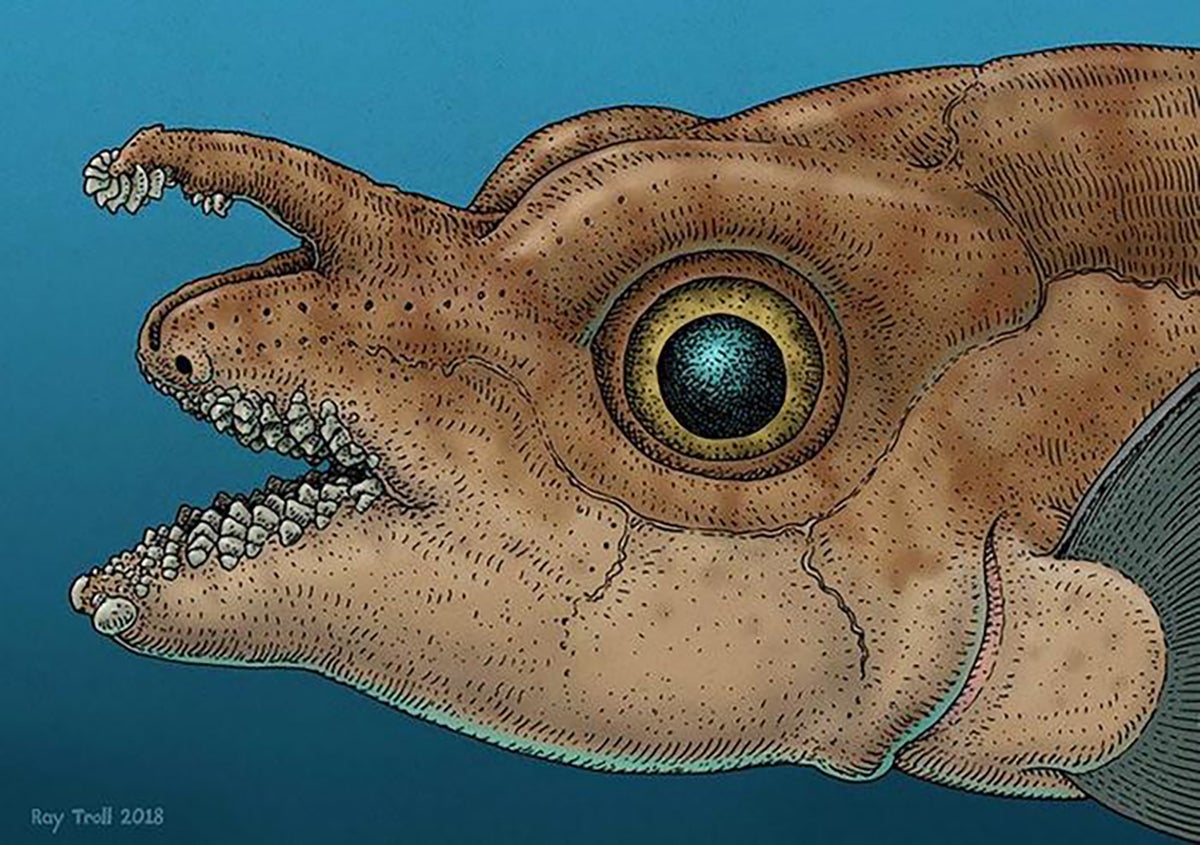This Gloriously Weird Fish Has Teeth on Its Forehead for Sex
Researchers have finally traced the origin of the spotted ratfish’s bizarre forehead teeth, which are used for mating
The researchers identified teeth on the tenaculum of ancient relatives to the modern adult male spotted ratfish. This fossil record helped them establish the historical significance of this structure, brought to life by local artist Ray Troll.
Join Our Community of Science Lovers!
The spotted ratfish is a two-foot-long fish with a big head and a long, skinny tail that lives in the northeastern Pacific Ocean. It belongs to a group of fish called chimaeras that are closely related to sharks. (Chimaeras are sometimes called ghost sharks.) Like most vertebrate creatures, it has teeth in its mouth. Unlike other vertebrates it also has teeth in another location: its forehead. It uses these forehead teeth for sex.
Researchers have long wondered where the ratfish’s forehead teeth come from. New research, published on September 4 in the Proceedings of the National Academy of Sciences USA, has traced their origin.
The ratfish’s extra teeth line a cartilaginous appendage called a tenaculum that in males can be erected and deployed to grasp a female during mating. Many fish have clasping appendages near the pelvis that they use to hold their mate close during the deed. The spotted ratfish has the tenaculum in addition to pelvic claspers.
If you’re enjoying this article, consider supporting our award-winning journalism by subscribing. By purchasing a subscription you are helping to ensure the future of impactful stories about the discoveries and ideas shaping our world today.
Scientists have known about the ratfish’s toothy tenaculum for a while. But they weren’t sure exactly how the teeth originated or how they ended up in this weird location outside the mouth. Many of the ratfish’s close relatives—the sharks, rays and skates—have toothlike structures in their skin called denticles that are made of the same material as teeth but are not true teeth. Are the ratfish’s forehead teeth just modified skin denticles, or do they share their structure and origin with mouth teeth?
To find out, Karly Cohen of the University of Washington and her colleagues traced the development of the ratfish’s tenaculum using micro-CT scans and tissue samples, and they compared the modern fish with fossil ancestors. The researchers determined that the ratfish’s forehead teeth are true teeth—they develop from a structure called the dental lamina that is present in the jaw but not in skin denticles. The dental lamina has never been found outside of the mouth until now.
Kate Wong is an award-winning science writer and senior editor at Scientific American focused on evolution, ecology, anthropology, archaeology, paleontology and animal behavior. She is fascinated by human origins, which she has covered for more than 25 years. Recently she has become obsessed with birds. Her reporting has taken her to caves in France and Croatia that Neandertals once called home, to the shores of Kenya’s Lake Turkana in search of the oldest stone tools in the world, to Madagascar on an expedition to unearth ancient mammals and dinosaurs, to the icy waters of Antarctica, where humpback whales feast on krill, and on a “Big Day” race around the state of Connecticut to find as many bird species as possible in 24 hours. Kate is co-author, with Donald Johanson, of Lucy’s Legacy: The Quest for Human Origins. She holds a bachelor of science degree in biological anthropology and zoology from the University of Michigan. Follow Kate on Bluesky.
If you enjoyed this article, I’d like to ask for your support. Scientific American has served as an advocate for science and industry for 180 years, and right now may be the most critical moment in that two-century history.
I’ve been a Scientific American subscriber since I was 12 years old, and it helped shape the way I look at the world. SciAm always educates and delights me, and inspires a sense of awe for our vast, beautiful universe. I hope it does that for you, too.
If you , you help ensure that our coverage is centered on meaningful research and discovery; that we have the resources to report on the decisions that threaten labs across the U.S.; and that we support both budding and working scientists at a time when the value of science itself too often goes unrecognized.
In return, you get essential news, captivating podcasts, brilliant infographics, , must-watch videos, challenging games, and the science world’s best writing and reporting. You can even gift someone a subscription.
There has never been a more important time for us to stand up and show why science matters. I hope you’ll support us in that mission.
Thank you,
David M. Ewalt, Editor in Chief, Scientific American
Source: www.scientificamerican.com
